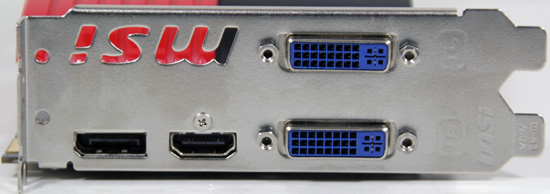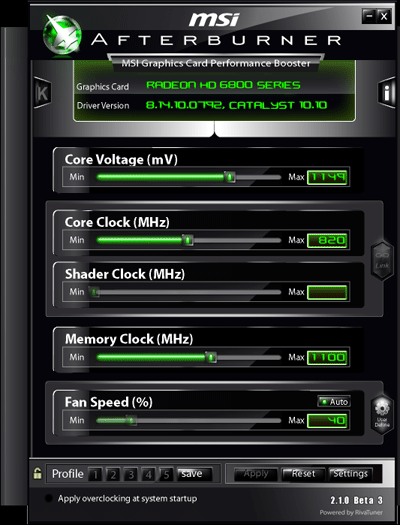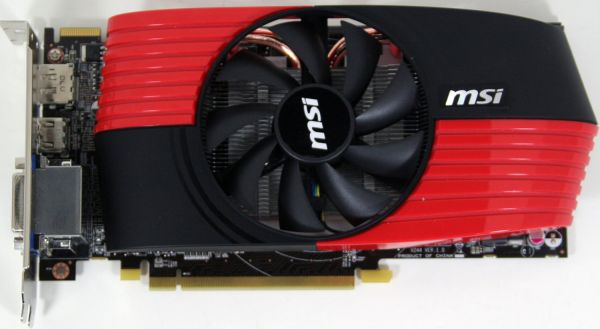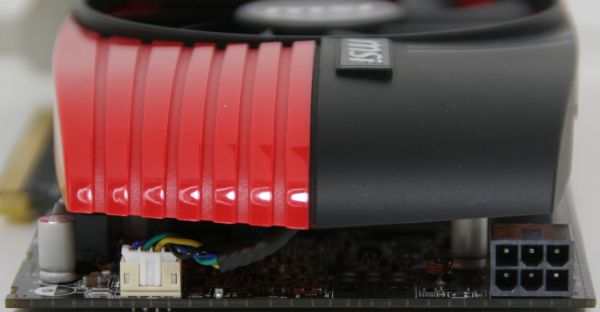AMD Radeon HD 6850 Overclocking Roundup: Asus, XFX, & MSI
by Ryan Smith on November 8, 2010 12:40 AM ESTMeet The MSI R6850 OC
The final card in today’s roundup is MSI’s R6850 OC. The R6850 OC is one of the first 6850s being released with a significant overclock, with MSI releasing it at 820MHz core and 1100MHz (4400MHz effective) memory, a 45MHz (5.8%) core and 100MHz (10%) memory overclock respectively. Besides the overclock, the card is identical to MSI’s existing R6850, using the same PCB and cooler as its stock-clocked counterpart.
Starting with the PCB, MSI is also using a non-reference PCB, this time using a shorter 8.5” PCB. In fact it's the same PCB as on the XFX card, leading us to believe that this is an alternative 1x DisplayPort PCB from AMD. In any case, because it's the same PCB as the XFX it means it's sharing the same design flaws: MSI has kept the PCIe power sockets on the rear of the card, so the practical length of the card is longer. Furthermore in the case of the MSI card, the card’s plastic shroud hangs over the end of the card, making the card 9” long in practice. As a result the end-user benefits of the shorter PCB are more or less wasted.
Attached to the PCB is MSI’s cooler, which bears a striking resemblance to Asus’s DirectCU cooler. Here MSI is using a pair of copper heatpipes to transfer heat from the baseplate to an aluminum heatsink that runs most of the length of the card. In the center is an 80mm fan providing airflow for cooling, and on top of that a shroud to direct airflow out of the front and the back of the card. Compared to the Asus DirectCU cooler, the biggest differences are that MSI is using a larger fan and copper heatpipes in place of aluminum heatpipes.
As for the port configuration, MSI is using the same configuration as both XFX and Asus: two DVI ports, one HDMI port, and one full-size DisplayPort, meaning the card can drive up to 5 monitors with a DP hub.

For the R6850, MSI’s ace in the hole is the software rather than the hardware. The R6850 comes with MSI’s fantastic Afterburner software, which comes with allows overclocking and monitoring, and on the R6850 it even allows voltage modification. While MSI makes this software available for use on non-MSI cards, we always make it a point to tip our hat in their direction as Afterburner continues to be the gold standard in overclocking software.

Rounding out the package is the usual collection of odds & ends: a quick-start manual, driver/utility CD, molex-to-PCIe power adaptor, a long CrossFire bridge, and a DVI-to-VGA dongle. Unfortunately we don’t have pricing information for the R6850 OC at this time, but we’ve already seeing the stock-clocked version at around $190, so we’d expect the R6850 OC to go for around $200, a $20 markup over the AMD MSRP for a reference card and roughly in-line with other factory overclocked cards. Meanwhile on the support side of matters, MSI is providing a 3 year warranty with the card.


















93 Comments
View All Comments
Will Robinson - Monday, November 8, 2010 - link
Yep, the stuff said so far about AT being smart to discuss this is right.I don't think anyone seriously believes the site would be biased.
I trust AT.
Having said that it's a shame those people who dismiss the complaints of many over the inclusion of overclocked cards don't wise up a bit.
They don't agree with you but it doesn't mean they are wrong.
expose - Monday, November 8, 2010 - link
What the title says, might as well admit within the article that you are catering to a audience and no longer practicing journalism. http://en.wikipedia.org/wiki/JournalismDoing a o/c feature on a card and then print a conclusion based on no results from the competitors stock o/c or any o/c results this time is amateur.
No longer professional or unbiased, and almost useless content because of random unpredictable motives.
jabber - Monday, November 8, 2010 - link
I was rather dissapointed two weeks ago when we had all the 6850/6870 reviews that put stock AMD units up against purely OCd Nvidia units and no one seemed to dare to just OC a 6850/70 to a similar degree for the sake of apples to apples. I guess Nvidia's review instructions to the tame (paid) press worked a charm.Ok so putting OCd AMD units against non OCd Nvidia units may redress the balance but its still not what any of us wanted to see in the first place.
Am I the only one not taking crazy pills around here?
We's like to see a list of stock AMD and Nvidia unit benchmarks and then a list of OCd AMD/Nvidia units.
Just like in the old days. Is that too hard?
FeynmanDIagrams - Monday, November 8, 2010 - link
Unfortunately reviewers can't always include 100 different comparisons due to time constraints. It takes a long time to benchmark a single card. This reviewer might not of had access to a 460FTW either.I use a standard MSI Cylone 460 1GB that I manually OC'd to 950/1050 on air. You don't have to buy the "super super overclocked" editions to get these speeds, just have adequate cooling. You're typically only going to find extreme overclock comparisons on overclocking forums rather than review sites.
While they don't include PhysX or CUDA, they are affordable mid-range cards that help keep competitor's prices in check. While AMD has had Crossfire driver issues in the past, Nvidia still seems to have major stuttering issues and low GPU usage for the past 9 months. They also seem to require you to run on a Bloomfield chip to have decent GPU usage(even that doesn't always fix it), where as even the 5870/5970 can make full use of the card on a modest Phenom or C2Q chip.
The 6850/6870 seem like excellent choices compared to their 460/470 competitors.
softdrinkviking - Monday, November 8, 2010 - link
you wrote... All of the cards could hit 850MHz core at stock clocksAll of the cards could hit 940MHz core at 1.172v, the 6870 load voltage
We had to give the cards significantly more voltage to get above 940MHz. This culminated at 1.22v on the Asus and MSI cards for 960MHz
I think "All of the cards could hit 850MHz core at stock clocks," should be "All of the cards could hit 850MHz at stock VOLTAGES," but maybe I am completely misunderstanding the info reported here?
jcn4boxes - Monday, November 8, 2010 - link
mm2587, while obviously upset, has a valid point.amd vs nvidia "fan boyz" should have no place in hardware reviews, imo.
rather the data should be presented and let that speak for itself.
i hope the "kicking to the curb" notion is just that and not a peace offering to a advertiser/contact.
Galcobar - Monday, November 8, 2010 - link
Never understood the flaming which results when a review includes factory overclocked video cards.For one point, it's not a YMMV situation -- a card purchased with a factory overclock will conform to those specifications. Think of it this way: if all the stock clocked cards were pulled from the market, would that mean the cards are no longer reviewable? Of course not, given the stock clocks are as much an arbitrary factory choice (to achieve a certain yield) as the overclocks.
Where it gets particularly odd is how processors whose only difference is the multiplier can be reviewed with no howls of indignation. When Intel turns up the multiplier and sticks a higher model number on it, they're issuing a factory overclocked chip and charging more for it. Yet no one complains a 950 should not be reviewed next to a 930...
The whole point of reviews is to look at price, performance, and the balance between.
khimera2000 - Monday, November 8, 2010 - link
ill give you a clue. one is overclocked, and represents the top of the OC scale for factory cards, also represents what a hand picked model can do.the other is a stock card.
at the time it was the only card i found that clocked at that speed, and the others trailed by at least 100mhz. the FTW card is just nvidia showing off and did not represent what was available on average at the time.
Just like now where its noted that its vary difficult to find non OC 6850, but these where not included in the review even though they where available the day i read the review.
it would mean that AT would have hand pick a card for every new releas. I can see that being a pain.
totenkopf - Monday, November 8, 2010 - link
Galcobar, your comparison to processors is a little misleading. when Intel augments the speed of their silicon, the respective parts are sold with distinct model numbers (950 vs. 930 as you pointed out) which is far different, and more dependable, than the 'OC' nomenclature. OCed graphics cards, on the other-hand, share the same technical designation with their non OCed counterparts. If little Billy asks his mom for a GTX460 FTW for Christmas, what do you suppose the odds are that he ends up with a stock GTX460 or some other 'OC' labeled variant?I will say that this whole argument is the stuff of fanboys. Purists and enthusiasts that frequent this site shouldn't be concerned with factory OC junk anyway, it all boils down to arguing over how one's favorite company is being represented. The whole OC edition thing is just money grab, product differentiation crap designed by OEMs to make people think they are getting a better product and part with more money. Usually the performance gain is negligible. Regardless, what good is an OCed card when they cost more money? The only consumer interest in OCing ought to be paying less to get more; which means you're better off getting the reference board for less money and making it faster. I don't think OCed cards have a place in reviews except in cases like this article. OCing was never supposed to be this mainstream, it defeats the whole purpose when it's up-cost marketing.
Besides, semantically speaking, if you buy it in that configuration, it's kinda still stock. The Shelby isn't an OCed Mustang... it's a Shelby. Tuning it yourself could be considered OCing.
Galcobar - Tuesday, November 9, 2010 - link
If you want to argue that the crucial difference lies in model numbers -- which is to say, labelling -- then you'd want to remember that cards with higher overclocks do use different model numbers.768-P3-1360-TR
768-P3-1362-TR
versus
i7-930
i7-950
That Intel sells the processors based directly on model number and uses the names in-house, while video cards are sold using the names and keeps the model numbers written small on the box doesn't really change the relationship.
Higher cost for what amounts to a software change.
Whether those software changes are worth paying for is another arguement entirely, but you are paying for an assured level of performance in either type of processor.